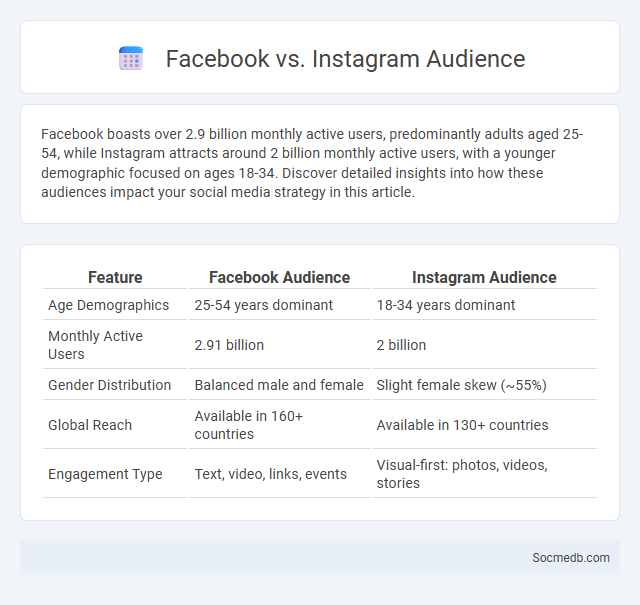
Photo illustration: Facebook vs Instagram Audience
Facebook boasts over 2.9 billion monthly active users, predominantly adults aged 25-54, while Instagram attracts around 2 billion monthly active users, with a younger demographic focused on ages 18-34. Discover detailed insights into how these audiences impact your social media strategy in this article.
Table of Comparison
| Feature | Facebook Audience | Instagram Audience |
|---|---|---|
| Age Demographics | 25-54 years dominant | 18-34 years dominant |
| Monthly Active Users | 2.91 billion | 2 billion |
| Gender Distribution | Balanced male and female | Slight female skew (~55%) |
| Global Reach | Available in 160+ countries | Available in 130+ countries |
| Engagement Type | Text, video, links, events | Visual-first: photos, videos, stories |
Understanding Facebook and Instagram Audiences
Facebook and Instagram audiences exhibit distinct demographic and behavioral patterns essential for targeted marketing strategies. Facebook users tend to be older, with a strong presence in the 25-54 age range, while Instagram attracts a younger, more visually-driven audience primarily aged 18-34. Understanding platform-specific engagement metrics, such as Facebook's emphasis on community groups and Instagram's focus on stories and reels, enables marketers to tailor content effectively for higher reach and conversion rates.
Demographic Comparison: Facebook vs Instagram
Facebook attracts a broader age range with strong user bases in the 25-54 demographic, while Instagram is particularly popular among younger audiences, especially those aged 18-34. Women tend to dominate Instagram's user base, whereas Facebook shows a more balanced gender distribution. Marketers targeting Gen Z and millennials prioritize Instagram for engagement, whereas Facebook remains key for reaching older generations and diverse demographic groups.
User Behavior: How Audiences Interact on Each Platform
User behavior on social media varies significantly across platforms, with Instagram users favoring visual content like photos and short videos, while Twitter audiences engage more in text-based discussions and real-time updates. Facebook facilitates community-building through groups and personal sharing, encouraging longer interactions, whereas TikTok's algorithm promotes rapid consumption of short, entertaining clips, driving high engagement through trends and challenges. Understanding these distinct interaction patterns helps tailor your content strategy to effectively capture and maintain audience interest on each platform.
Content Preferences: What Each Audience Responds To
Different social media platforms attract unique audiences with distinct content preferences; millennials often engage more with authentic, visually appealing stories on Instagram, while Gen Z favors short, dynamic videos on TikTok that emphasize creativity and humor. LinkedIn users typically respond best to professional insights, industry news, and thought leadership articles, making it ideal for B2B marketing. Understanding these nuances ensures your content resonates deeply, boosting engagement and driving meaningful connections.
Platform Engagement: Facebook vs Instagram Metrics
Facebook and Instagram offer distinct platform engagement metrics critical for evaluating social media performance. Facebook metrics emphasize likes, shares, comments, and click-through rates, reflecting user interaction and content virality. Instagram engagement highlights include impressions, story views, and follower growth, providing insights into visual content impact and audience retention, helping you tailor strategies effectively.
Brand Reach: Targeting Potential Customers
Social media platforms offer unparalleled opportunities to expand brand reach by targeting potential customers through advanced demographic, interest-based, and behavioral filters. Utilizing tools such as Facebook Ads Manager, Instagram promotions, and LinkedIn Sponsored Content enables precise audience segmentation and personalized messaging. This targeted approach increases brand visibility, engagement rates, and conversion potential in competitive digital markets.
Defining Your Target Audience
Identifying your target audience on social media involves analyzing demographic data, interests, and online behaviors to tailor content that resonates effectively. Understanding your audience's preferences and pain points helps optimize engagement and boosts conversion rates. You can leverage tools like Facebook Insights and Google Analytics to gain precise insights and refine your marketing strategy accordingly.
Choosing the Right Platform for Your Target Audience
Selecting the right social media platform is crucial for effectively reaching your target audience and maximizing engagement. Understanding the demographics, interests, and behaviors of your ideal customers allows you to tailor your content to platforms like Instagram for younger users, LinkedIn for professionals, or Facebook for a broader age range. You can increase your brand's visibility and conversion rates by focusing on the platforms where your audience spends the most time.
Customizing Marketing Strategies by Platform
Tailoring marketing strategies to each social media platform maximizes engagement and conversion rates. Utilizing Instagram's visual storytelling and influencer collaborations enhances brand awareness, while LinkedIn's professional network supports B2B lead generation through targeted content and thought leadership. Data-driven customization on Facebook's diverse audience enables precise ad targeting and retargeting campaigns, increasing overall ROI.
Maximizing ROI: Audience Targeting Best Practices
Maximizing ROI on social media requires precise audience targeting using data-driven strategies such as behavioral analytics, demographic segmentation, and psychographic profiling to deliver personalized content. Utilizing platforms' advanced targeting tools, such as Facebook Ads Manager and LinkedIn Campaign Manager, enhances conversion rates by focusing on high-intent customer segments. Continuous A/B testing and real-time performance tracking ensure budget efficiency and optimize ad spend for measurable return on investment.
 socmedb.com
socmedb.com